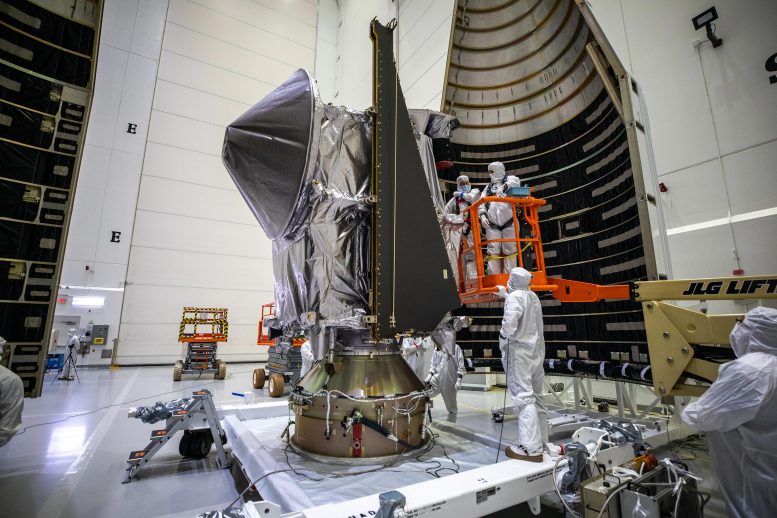A full Moon rises over Vasquez Rocks Natural Area Park in Santa Clarita, California, on June 24, 2021. Credit: NASA/Preston Dyches
The Next Full Moon is the Hunter’s Moon; the Travel, Dying Grass, Sanguine, or Blood Moon; Shared Purnima; Pavarana; the full Moon of the Thadingyut Festival of Lights, the Phaung Daw Oo Pagoda Festival, and the Boun Suang Huea or the Boat Racing Festival; and the Lucy Moon.
The next full Moon will be on Wednesday morning, October 20, 2021, appearing opposite the Sun (in Earth-based longitude) at 10:57 a.m. EDT. This will be on Wednesday for much of the world but will be on Thursday from Australian Central Standard time eastward to the International Date Line. The Moon will appear full for about three days around this time, from Monday night into Thursday night.
As the full Moon after the Harvest Moon, this will be the Hunter’s Moon. The earliest use of the term “Hunter’s Moon” cited in the Oxford English Dictionary is from 1710. According to the Farmer’s Almanac, with the leaves falling and the deer fattened, it is time to hunt. Since the harvesters have reaped the fields, hunters can easily see the animals that have come out to glean (and the foxes that have come out to prey on them).
The Maine Farmer’s Almanac first published Native American names for the full Moons in the 1930s. Over time, these names have become widely known and used. According to this almanac, as the full Moon in October the Algonquin tribes in what is now the northeastern U.S. called this the Travel Moon, the Dying Grass Moon, or the Sanguine or Blood Moon. Some sources indicate that the Dying Grass, Sanguine, and Blood Moon names are related to the turning of the leaves and dying back of plants with the start of fall. Others indicate that the names Sanguine or Blood Moon are associated with hunting to prepare for winter.
I have read that the name Travel Moon comes from observing the migration of birds and other animals preparing for the winter. I don’t know, but this name may also refer to the season when the more northern tribes would move down from the mountains for the winter. For example, both the Iroquois and Algonquin would hunt in the Adirondacks in the summertime but would leave to avoid the harsh mountain winter.
This full Moon occurs around the end of the seasonal monsoon rains in the Indian subcontinent. It marks the end of the month of Ashvin in the traditional Hindu calendar and Thadingyut in the traditional Burmese calendar.
For Hindus, this is Sharad Purnima, a harvest festival celebrated in a variety of ways throughout India.
For Buddhists, this Moon marks the end of Vassa, the three-month period of fasting for Buddhist monks tied to the monsoons (Vassa is sometimes given the English names Rains Retreat or Buddhist Lent). There are numerous festivals and holy days associated with this Moon at the end of Vassa. Many Buddhists observe the holy day Pavarana on this day. In Myanmar, this full Moon corresponds with the three-day Thadingyut Festival of Lights, also known as the Lighting Festival of Myanmar. Also in Myanmar, this full Moon is near the end of the Phaung Daw Oo Pagoda Festival. This festival began on the first Waxing Moon day of the month of Thadingyut (October 6, 2021) and will end a few days past the full Moon (October 23). In Laos, this full Moon corresponds with Boun Suang Huea or the Boat Racing Festival.
Another name for this full Moon is the Lucy Moon, for the
Workers inside the Astrotech Space Operations Facility in Titusville, Florida, move the first half of the United Launch Alliance (ULA) payload fairing toward NASA’s Lucy spacecraft on September 30, 2021. Credit: NASA/Ben Smegelsky
(function(d, s, id){
var js, fjs = d.getElementsByTagName(s)[0];
if (d.getElementById(id)) return;
js = d.createElement(s); js.id = id;
js.src = "https://connect.facebook.net/en_US/sdk.js#xfbml=1&version=v2.6";
fjs.parentNode.insertBefore(js, fjs);
}(document, 'script', 'facebook-jssdk'));
Read original article here
